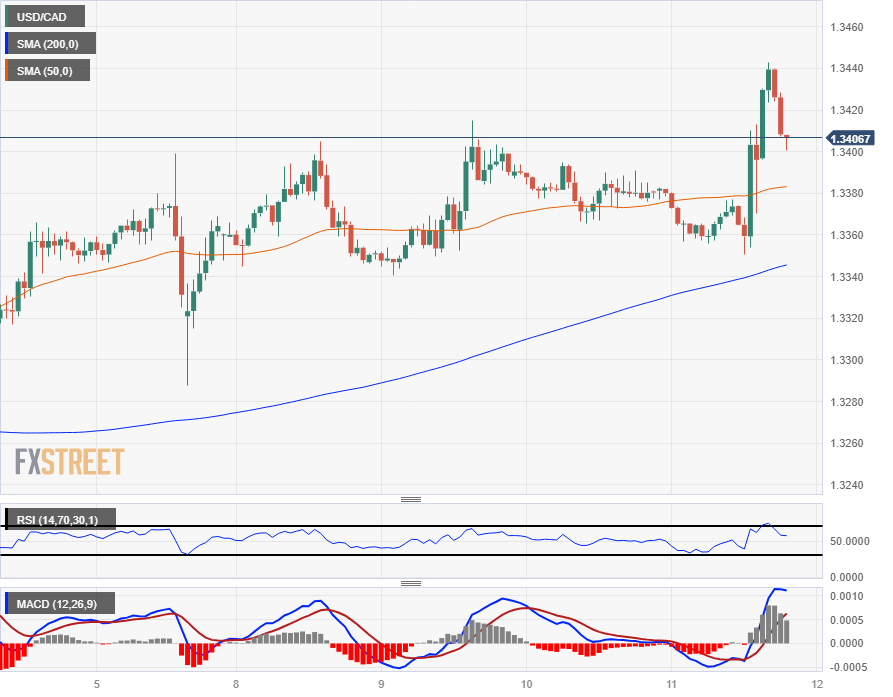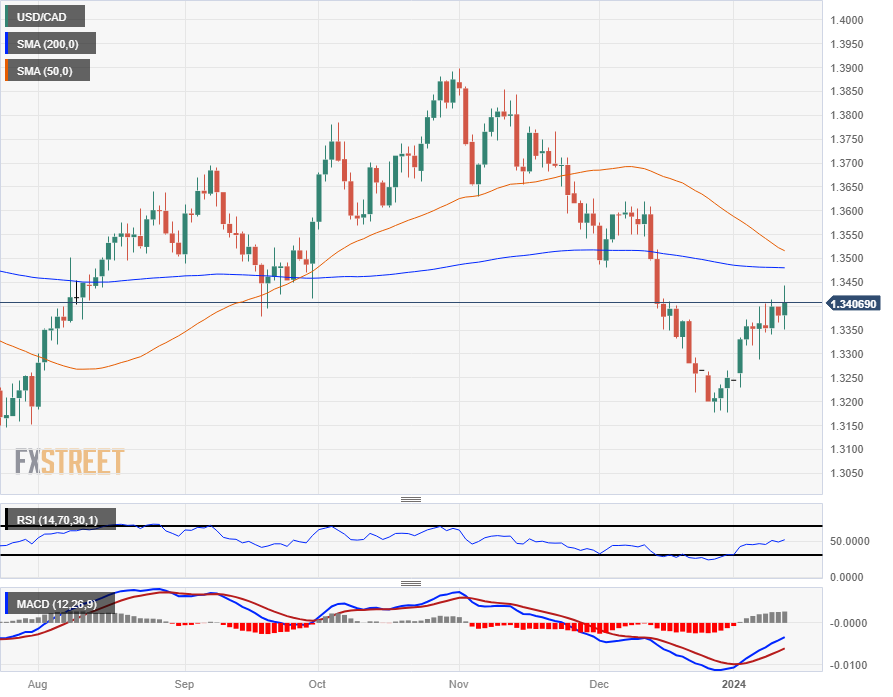Most recent article: Canadian Dollar is a mixed bag on Friday, softer overall on the week
- Canadian Dollar falls back as US CPI inflation kicks higher.
- Canada economic data remains absent until next week.
- Rising inflation makes rate cuts difficult.
The Canadian Dollar (CAD) is mostly lower on Thursday as broader markets pivot into safe haven currencies after US inflation from the Consumer Price Index (CPI) ticked broadly higher than markets were expecting, widening the gap between market hopes of a March rate cut and the Federal Reserve’s (Fed) current stance.
Economic data from Canada remains absent from the data docket for the rest of the week, leaving CAD traders waiting for next week’s Canada CPI print as well as Canadian Retail Sales figures from November, due next Tuesday and Friday, respectively.
Daily digest market movers: Canadian Dollar follows broader market lower as markets pile into the safe haven Greenback
- Canadian Dollar sees declines as markets bid up the US Dollar post-CPI.
- US inflation is driving markets into safe havens after US CPI broadly thumped market forecasts.
- CAD is getting little support from Crude Oil despite a near-term rise in barrel bids, WTI clips back over $73.50.
- Headline monthly US CPI inflation ticked higher in December to 0.3% versus the forecast of 0.2%, climbing over November’s 0.1%.
- Annualized CPI inflation rose to 3.4% in December, climbing over the median market forecast of 3.2% and extending from November’s annualized 3.1% print.
- Core annualized CPI through December fell from the previous 4.0% to 3.9%, but less than the market’s 3.8% forecast.
- Despite the upside surprise in US CPI inflation, bond markets remain stubbornly resilient even as safe havens climb and equities decline.
- Policy-sensitive 2-year US Treasury yield staunchly continues to bet on rate cuts sooner rather than later as yield slips a scant 0.2%.
- Up next: US Producer Price Index (PPI) inflation on Friday, where markets will be hoping for further price declines on the front end of the supply chain.
- Core PPI (headline PPI less volatile food and energy prices) is expected to decline from 2.0% to 1.9% for the year ending in December.
Canadian Dollar price today
The table below shows the percentage change of Canadian Dollar (CAD) against listed major currencies today. Canadian Dollar was the weakest against the Pound Sterling.
| USD | EUR | GBP | CAD | AUD | JPY | NZD | CHF | |
| USD | 0.04% | -0.07% | 0.17% | 0.38% | -0.02% | 0.04% | 0.40% | |
| EUR | -0.04% | -0.11% | 0.14% | 0.35% | -0.03% | 0.00% | 0.38% | |
| GBP | 0.06% | 0.11% | 0.26% | 0.46% | 0.05% | 0.10% | 0.48% | |
| CAD | -0.17% | -0.14% | -0.25% | 0.21% | -0.20% | -0.13% | 0.24% | |
| AUD | -0.38% | -0.33% | -0.44% | -0.20% | -0.39% | -0.34% | 0.04% | |
| JPY | 0.02% | 0.06% | -0.06% | 0.17% | 0.39% | 0.04% | 0.42% | |
| NZD | -0.04% | 0.02% | -0.10% | 0.13% | 0.33% | -0.06% | 0.39% | |
| CHF | -0.42% | -0.38% | -0.49% | -0.24% | -0.02% | -0.44% | -0.37% |
The heat map shows percentage changes of major currencies against each other. The base currency is picked from the left column, while the quote currency is picked from the top row. For example, if you pick the Euro from the left column and move along the horizontal line to the Japanese Yen, the percentage change displayed in the box will represent EUR (base)/JPY (quote).
Technical Analysis: Canadian Dollar backslides in broad-market US Dollar bid
The Canadian Dollar (CAD) is broadly lower on Thursday, gaining a fifth of a percent against the Australian Dollar (AUD) and a quarter of a percent against the Swiss Franc (CHF). The Loonie has shed a fifth of a percent against the Japanese Yen (JPY) and a quarter of a percent aginst the Euro (EUR), and the CAD is also down around a fifth of a percent against the US Dollar heading into the tail end of the trading week.
The Canadian Dollar tumbled against the US Dollar post-CPI, sending the USD/CAD pair toward 1.3450 after hitting a near-term low of 1.3350 in the run-up to US inflation prints. The pair is seeing a limited recovery in the post-CPI wrap-up, but still remains in the green for the day as the Loonie remains weaker against the inflation-fueled US Dollar.
Intraday, USD/CAD bids continue to be buoyed above the 200-hour Simple Moving Average (SMA) near 1.3340. Prices continue to run above the near-term median since crossing the moving average at the outset of 2024’s trading.
Thursday’s bump in the USD/CAD drags the pair within reach of the 200-day SMA near the 1.3500 handle, but continued bullish momentum faces near-term technical resistance as the 50-day SMA declines, heading into a bearish crossover of the long-term moving average. The USD/CAD has closed flat or bullish for nine of the last ten consecutive trading days and is on pace to make it a tenth green day.
The USD/CAD is now up 2% from late December’s bottom bids near 1.3177 but remains down around 3.3% from October’s peak near the 1.3900 handle.
USD/CAD Hourly Chart

USD/CAD Daily Chart

Canadian Dollar FAQs
What key factors drive the Canadian Dollar?
The key factors driving the Canadian Dollar (CAD) are the level of interest rates set by the Bank of Canada (BoC), the price of Oil, Canada’s largest export, the health of its economy, inflation and the Trade Balance, which is the difference between the value of Canada’s exports versus its imports. Other factors include market sentiment – whether investors are taking on more risky assets (risk-on) or seeking safe-havens (risk-off) – with risk-on being CAD-positive. As its largest trading partner, the health of the US economy is also a key factor influencing the Canadian Dollar.
How do the decisions of the Bank of Canada impact the Canadian Dollar?
The Bank of Canada (BoC) has a significant influence on the Canadian Dollar by setting the level of interest rates that banks can lend to one another. This influences the level of interest rates for everyone. The main goal of the BoC is to maintain inflation at 1-3% by adjusting interest rates up or down. Relatively higher interest rates tend to be positive for the CAD. The Bank of Canada can also use quantitative easing and tightening to influence credit conditions, with the former CAD-negative and the latter CAD-positive.
How does the price of Oil impact the Canadian Dollar?
The price of Oil is a key factor impacting the value of the Canadian Dollar. Petroleum is Canada’s biggest export, so Oil price tends to have an immediate impact on the CAD value. Generally, if Oil price rises CAD also goes up, as aggregate demand for the currency increases. The opposite is the case if the price of Oil falls. Higher Oil prices also tend to result in a greater likelihood of a positive Trade Balance, which is also supportive of the CAD.
How does inflation data impact the value of the Canadian Dollar?
While inflation had always traditionally been thought of as a negative factor for a currency since it lowers the value of money, the opposite has actually been the case in modern times with the relaxation of cross-border capital controls. Higher inflation tends to lead central banks to put up interest rates which attracts more capital inflows from global investors seeking a lucrative place to keep their money. This increases demand for the local currency, which in Canada’s case is the Canadian Dollar.
How does economic data influence the value of the Canadian Dollar?
Macroeconomic data releases gauge the health of the economy and can have an impact on the Canadian Dollar. Indicators such as GDP, Manufacturing and Services PMIs, employment, and consumer sentiment surveys can all influence the direction of the CAD. A strong economy is good for the Canadian Dollar. Not only does it attract more foreign investment but it may encourage the Bank of Canada to put up interest rates, leading to a stronger currency. If economic data is weak, however, the CAD is likely to fall.
Information on these pages contains forward-looking statements that involve risks and uncertainties. Markets and instruments profiled on this page are for informational purposes only and should not in any way come across as a recommendation to buy or sell in these assets. You should do your own thorough research before making any investment decisions. FXStreet does not in any way guarantee that this information is free from mistakes, errors, or material misstatements. It also does not guarantee that this information is of a timely nature. Investing in Open Markets involves a great deal of risk, including the loss of all or a portion of your investment, as well as emotional distress. All risks, losses and costs associated with investing, including total loss of principal, are your responsibility. The views and opinions expressed in this article are those of the authors and do not necessarily reflect the official policy or position of FXStreet nor its advertisers. The author will not be held responsible for information that is found at the end of links posted on this page.
If not otherwise explicitly mentioned in the body of the article, at the time of writing, the author has no position in any stock mentioned in this article and no business relationship with any company mentioned. The author has not received compensation for writing this article, other than from FXStreet.
FXStreet and the author do not provide personalized recommendations. The author makes no representations as to the accuracy, completeness, or suitability of this information. FXStreet and the author will not be liable for any errors, omissions or any losses, injuries or damages arising from this information and its display or use. Errors and omissions excepted.
The author and FXStreet are not registered investment advisors and nothing in this article is intended to be investment advice.
Recommended content
Editors’ Picks

EUR/USD holds above 1.0400 in quiet trading
EUR/USD trades in positive territory above 1.0400 in the American session on Friday. The absence of fundamental drivers and thin trading conditions on the holiday-shortened week make it difficult for the pair to gather directional momentum.

GBP/USD recovers above 1.2550 following earlier decline
GBP/USD regains its traction and trades above 1.2550 after declining toward 1.2500 earlier in the day. Nevertheless, the cautious market mood limits the pair's upside as trading volumes remain low following the Christmas break.

Gold declines below $2,620, erases weekly gains
Gold edges lower in the second half of the day and trades below $2,620, looking to end the week marginally lower. Although the cautious market mood helps XAU/USD hold its ground, growing expectations for a less-dovish Fed policy outlook caps the pair's upside.

Bitcoin misses Santa rally even as on-chain metrics show signs of price recovery
Bitcoin (BTC) price hovers around $97,000 on Friday, erasing most of the gains from earlier this week, as the largest cryptocurrency missed the so-called Santa Claus rally, the increase in prices prior to and immediately following Christmas Day.

2025 outlook: What is next for developed economies and currencies?
As the door closes in 2024, and while the year feels like it has passed in the blink of an eye, a lot has happened. If I had to summarise it all in four words, it would be: ‘a year of surprises’.

Best Forex Brokers with Low Spreads
VERIFIED Low spreads are crucial for reducing trading costs. Explore top Forex brokers offering competitive spreads and high leverage. Compare options for EUR/USD, GBP/USD, USD/JPY, and Gold.